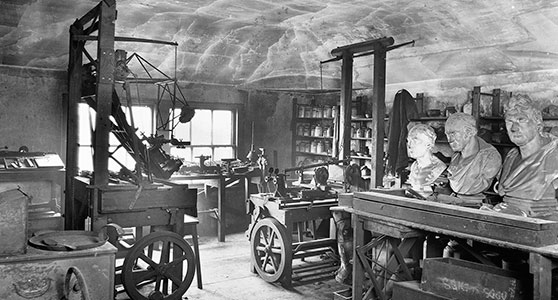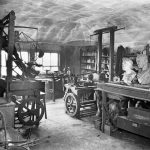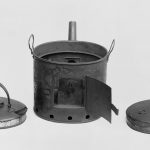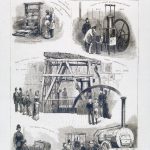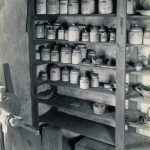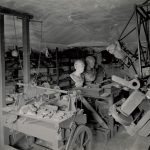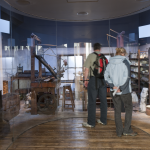Watt’s workshop: craft and philosophy in the Science Museum
Article DOI: https://dx.doi.org/10.15180/140106
Abstract
Accounts of the life of Scottish engineer James Watt have tended to take a rather monocular approach to his life’s work – primarily concentrating on the steam engine. However, the evidence of Watt’s workshop, preserved at the Science Museum, points to the diverse nature of his interests, and particularly to the close integration of philosophical and pragmatic elements in his work. Here is the workplace of one of the savant-fabricants that Britain’s ‘Industrial Enlightenment’ depended upon. All was, however, underpinned by physical work and the creation of tangible artefacts that took into account a range of factors at once technological, entrepreneurial, aesthetic and consumer-driven, a point worth emphasising in consideration both of Britain’s industrial revolution and the recent debate about a re-balancing of the UK economy towards manufacturing.
Keywords
Bennet Woodcroft, Birmingham, consumption, Heathfield, industrial enlightenment, industry, James Watt, making, mechanical engineering, Museum, Patent Office Museum, sculpture-copying, Watt, Watt's workshop, workshop
Watt’s workshop: Craft and Philosophy in the Science Museum
https://dx.doi.org/10.15180/140106/008In March 2011, the Science Museum redisplayed the complete workshop of Scottish engineer James Watt as the centrepiece of a major new permanent gallery (Science Museum: James Watt [online]). The workshop was acquired by the museum from Watt’s home, ‘Heathfield’, at Handsworth in Birmingham, in 1924 (see Figure 1).
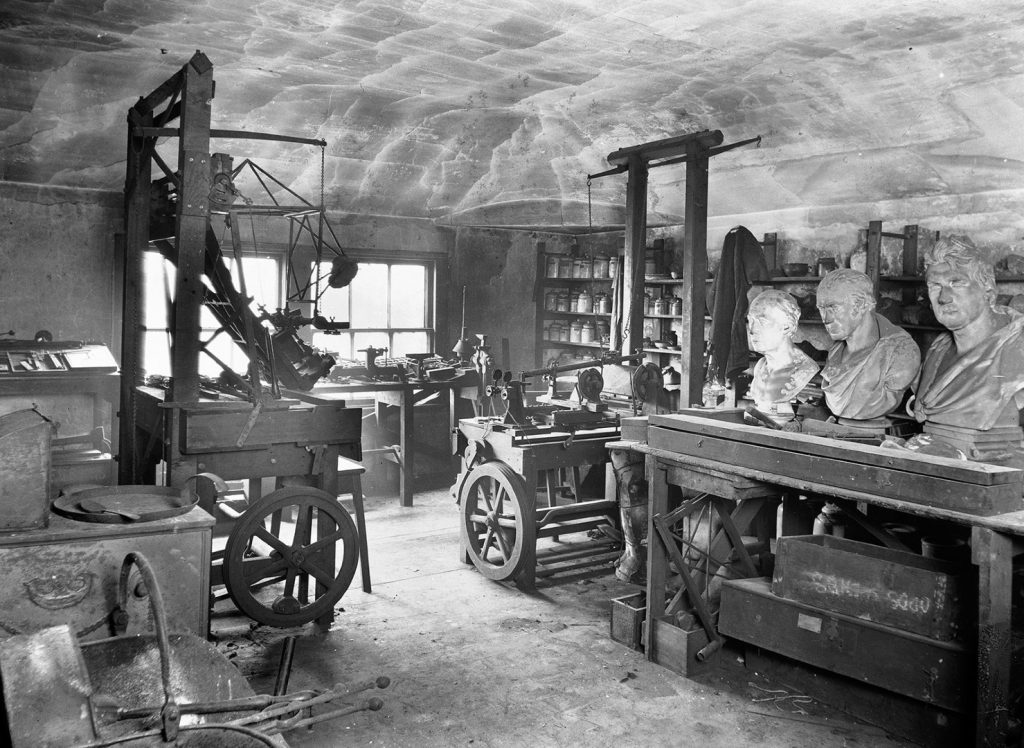
In that year, the workshop and its complete contents (more than 8,400 objects), along with the door and window, skylight, floorboards, and even a section of the banisters from outside, complete with a shelf where servants could allegedly leave food for Watt if he was heavily engaged within, were all packed up and transported to South Kensington.
The workshop is a fascinating survival: not a modern museum ‘room setting’, but a complete and original time capsule. When Watt had Heathfield built in 1790, as he began to extricate himself from a long career building steam engines with his business partner Matthew Boulton, he put aside a room on the second floor for storage. Gradually, this room was transformed from a store into a well equipped workshop with a stove, chests of drawers and a cupboard, shelves, a lathe and a workbench. Watt’s wife possibly had a hand in his removal to the attic. Being endowed with ‘the thrifty and far-seeing habits of the most enlightened Scotch housewifery’ (which extended to having the family’s pet dogs trained to wipe their feet when they entered the house), she would surely not have tolerated Watt’s penchant for mess-generating experiments of all kinds anywhere else (Hankin (ed), 1859).
When Watt died in 1819, the workshop and its contents were left to his son, James Watt Junior, and the room was carefully locked up and left entirely untouched at least until he in turn died in 1848. After that date, a very few visitors were permitted entry. Watt’s biographer J P Muirhead, who visited the workshop in 1853, described it as a ‘religio loci’, a place of sanctity, and an industrial shrine to Watt the steam engineer where no ‘profane hand’ had been allowed to ‘violate the sanctities’ of this ‘magical retreat’ (Muirhead, 1854).
A decade later, Francis Pettit-Smith of the Patent Office Museum, whose collection formed a nucleus for the Science Museum, wrote to Watt’s great-grandson James Gibson-Watt. ‘How often I have longed to take a peep into Heathfield…where I am informed a host of invaluable relics do still exist – which in honour to the illustrious man should once more see the daylight – and be preserved to the end of time in some public institute like this[1]. This rather unsubtle approach was continued when Pettit-Smith, along with Bennet Woodcroft, the Museum’s founder, finally gained entrance to the workshop in April 1864. The two men fought to open the door for 20 minutes, accidentally broke one of the windows, and Woodcroft left his glasses behind afterwards having spent seven hours examining the workshop’s contents[2].
Thereafter, the workshop remained at Heathfield all the way up to 1924, 105 years after Watt’s death. The contents were in poor condition, having been subject to extremes of heat in summer, and cold in winter, with the wooden items sometimes attacked by woodworm. As Birmingham expanded in the 1920s, Heathfield, and the grounds around it, were sold for development. A final set of photographs commissioned by the Science Museum at the end of 1924 shows the workshop contents covered with dirt, and a view from the window reveals neglected brick-work, tiles slipping from the roof, and the grounds and outbuildings decaying[3]. In December, H W Dickinson, the Science Museum’s curator of mechanical engineering, arrived with trucks and men to remove the workshop contents. How close the house was to being swept away is suggested by the floorboards and other structural elements having to be acquired separately, not from Watt’s descendants, but from those redeveloping the site.
The workshop was a practical workplace for Watt, but it was also his personal museum: it contains remnants of many of his earlier projects, from those on the nature and properties of heat, through the ingredients used in devising ink for letter-copying purposes, to ways of mass-producing musical and scientific instruments – a reminder that Watt began his career as an instrument-maker and merchant in Glasgow following a brief spell in London in 1755–56.
As well as tools and instruments, many of the objects in the workshop would have had deep personal resonance for Watt. In one corner remains a trunk containing the school books, drawings, paintings and writings of his son Gregory, who died of tuberculosis in 1804, aged only 27. More enigmatically, among the many plaster moulds that sit on the workshop shelves (themselves a rare survival of the plaster copy industry that grew in the early 19th century based on the work of itinerant Italian mould-makers) sits a mould which, when taken apart, reveals the imprinted fingers of a small child: perhaps a keepsake of one of Watt’s three children who died in infancy.
Finally, on the bed of one of Watt’s sculpture-copying machines, which were his major interest in retirement, and the only project carried to fruition in the workshop, rests a death-mask of Matthew Boulton, who died in 1809. The mask became a subject for Watt to multiply on the copying machines. The impression of Watt one obtains from the evidence of the workshop is of some sadness, of family and friends slipping away, as Watt sat by the stove in his garret.
The contents of the workshop are also revealing in other ways. Although the contents were meticulously listed in a series of inventories during the later 19th century, the occasional ‘rogue’ object has surfaced: for example, a large, inverted ceramic cone, which curators had assumed to be a part of Watt’s chemical experiments, turned out on further research to be a lavatory bowl dating from the 1850s onwards. Research also suggests that the Pemberton family, tenants who lived at Heathfield in the 1860s, allowed their children to get their hands on the workshop key – they had already found Watt’s old furniture stored in an out-house, and ‘filled up corners and other odd spaces in play and bed-rooms with costly old cabinets and bureaux and within them displayed our treasures’ (Pemberton, 1905). Later photographs of objects preserved in an album held by the Heathfield Historical Society shows mineral models made of boxwood removed from the workshop and lined up to spell out the word ‘CRYSTALS’ (Digital Handsworth: Boxwood crystals made by James Watt, [online]). Rather than being an untouched place of sanctity, it would appear that the objects inside the workshop sometimes had rather itinerant lives.
In seeking to redisplay the workshop in a new exhibition, it was necessary to locate Watt in the broader historiography of the later 18th century. In his book James Watt, Chemist (the latest in a series of books by different authors examining the work of this great engineer and polymath), David Miller has written an invigorating exploration of a career where designing and building steam engines happened in close conjunction with chemical experiments. In his lifetime, Watt was an influential chemist as well as an engineer, and he took care to emphasise the philosophical nature of his work on the properties of steam, as opposed to the industrial applications of its power. This path was also adopted by Watt Jnr, who assiduously cultivated the memory of his late father as a philosopher after he died in 1819, and who became the custodian of the workshop in that year (Miller, 2004).
The story that the young Watt experimented with a kettle and from it deduced the capabilities of steam became a parable for steam-powered Victorian Britain, captured and romanticised in a series of popular prints and other images. The story itself has become the subject of controversy: most recently, David Miller has revealed how Watt Jnr subtly altered the original account of the kettle incident so that it reflected an interest in steam’s philosophical properties (Miller, 2004).
The fascination with the kettle story in the 19th century can be neatly encapsulated in another acquisition made by the Patent Office Museum, in 1863. Francis Pettit-Smith was in touch with J W Gibson-Watt, then head of the Watt family, concerning a ‘kettle’ said to be in his possession, which had belonged to James Watt himself. After some consideration, Gibson-Watt wrote that although the kettle had been removed by James Watt Jnr following his father’s death in 1819, it was ‘not a “tea kettle” at all, and I am satisfied it is not…the one which he originally observed the steam lifting the lid when boiling on the fire’. However, it was ‘evidently made by his orders and used as an experimentalising steam kettle, it has a moveable funnel and two parts that lift out’[4]. Francis Pettit-Smith remained intrigued, replying that ‘of course the identical kettle referred to in the paper article would have been if possible more interesting than the one which you have in your possession. Still as this one was actually constructed for and used by James Watt in his early investigations of the properties of steam it cannot fail to attract great notice and prove to be a very interesting + valuable acquisition’[5].
The kettle was subsequently delivered to the Patent Office Museum by Richard Banks, Gibson-Watt’s solicitor[6]. It remains in the Science Museum’s collection, and is on display in the Secret Life of the Home gallery[7] (see Figure 2).
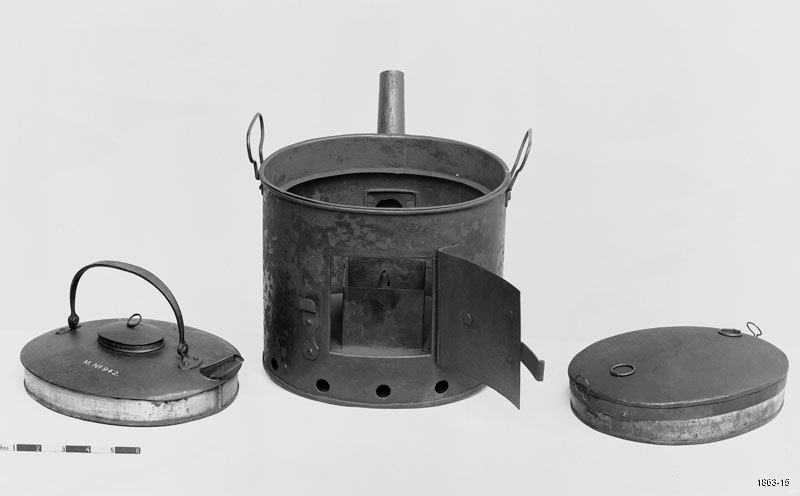
The account of the kettle’s acquisition is interesting for two reasons. First, considerable enthusiasm was shown for the object even though it was not what it was originally conceived to be – its associations alone were enough to make it a valuable acquisition[8]. Second, the exchange of letters about the kettle is couched in the language of philosophy, using words like ‘experimentalising’, and referring to the ‘properties’ of steam. Pettit-Smith appears anxious to use the terms that Watt himself would have favoured, but they are at odds with many of the Patent Office Museum’s other acquisitions at this time, particularly Watt’s ‘Old Bess’ and ‘Lap’ steam engines, which were very much about steam as an industrial power source[9] (see Figure 3).
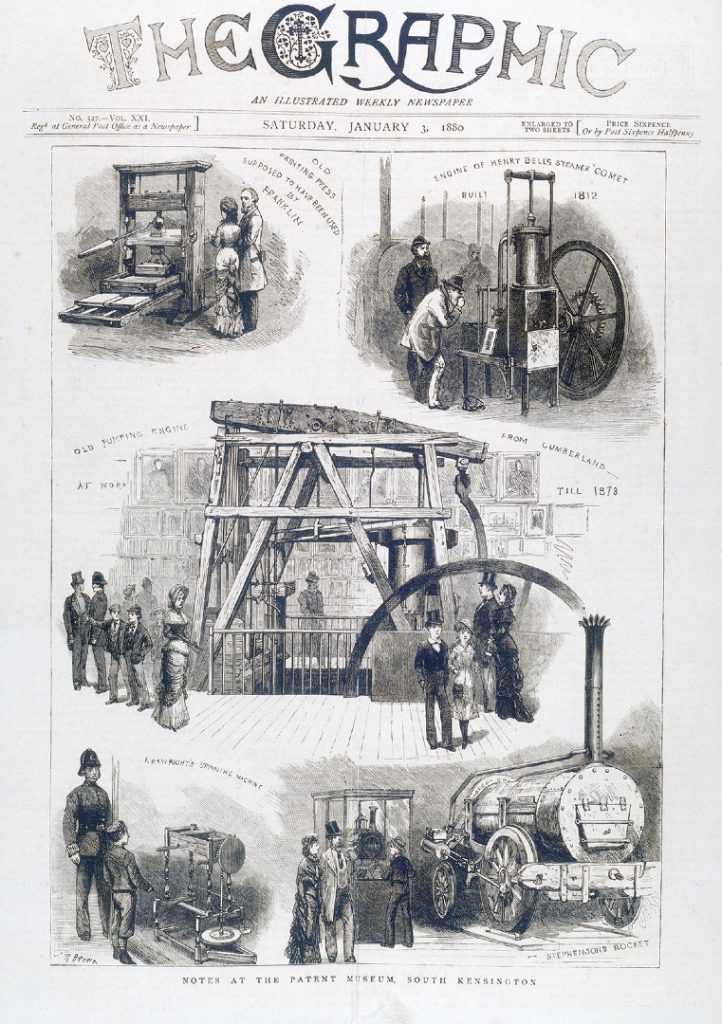
In the acquisition of the alleged Watt kettle, and Watt’s workshop, are captured two different ideas of Watt, as a philosopher and as a craftsman. The balance between these two has varied over time. During the 19th century, Watt’s engineering achievements were afforded far greater prominence over his philosophical and chemical background. Other historians have picked up on these competing interpretations of Watt, particularly Christine MacLeod, in Heroes of Invention (MacLeod, 2007). Here, MacLeod explores how Watt became a highly contested figure, appropriated and re-appropriated by a series of different interest groups. Watt was the first engineer to ascend into Britain’s pantheon of national heroes, where he was later joined by others including George Stephenson and Isambard Kingdom Brunel, as Britain was transformed by bold new civil-engineering projects. As the 19th century drew to a close, engineers and inventors were being praised less as scientists, and ‘applied science’ attained greater prominence (MacLeod, & Tann, 2007). By the centenary of Watt’s death in 1919, he had once more become a revered craftsman and engineer[10]. Most recently, Watt’s philosophical and chemical interests, and his role in the wider Enlightenment, have been reassessed[11].
As has been suggested by David Miller, Watt was subject to a set of competing forces, concerning representations and realities, the mechanical and the chemical, philosophy and craft (Miller, 2009). Although Watt has often been defined in polar terms, as either philosopher or craftsman, mechanic or chemist, the physical evidence of the workshop allows us to expand upon what Miller has already said and argue for Watt as a liminal figure, existing in an intermediate state between different extremes. Specific aspects of one of these polar relationships have often been emphasised in the construction of a particular historical argument, but the workshop suggests that all these different aspects could be accommodated within a single person: Watt lived in many different worlds.
The workshop was acquired as a shrine to the man Thomas Carlyle called ‘Watt of the Steam engine… this man with blackened fingers, with grim brow…searching out, in his Workshop, the Fire-secret’ (Carlyle, 1869). However, there is very little in the workshop pertaining to the steam engine. Out of more than 8,000 objects, only seven or eight can be linked directly to Watt’s steam projects, although what there is has proved to be very significant, such as the original model of the separate condenser, which was concealed amid the mess of objects on the workbench until the late 1960s, when it was finally identified by Rodney Law (Law, 1969). These steam artefacts are accompanied by a multiplicity of other items, covering not just science and technology, but aspects of the decorative arts and the world of consumption, too. There are 26 plaster moulds to copy figures designed after the Antique as well as some hundreds of small pieces of sculpture, cameos and portrait medallions intended as feedstock for Watt’s sculpture-copying machines. The workshop drawers contain tools intended for the manufacture of musical instruments: there is a complete set of tools, reamers and rotary files for making flutes in bulk, and ‘purfling’ tools to inlay thin strips of wood into the bodies of stringed instruments[12]. There are also more than 140 different chemical substances tied up in paper wrappers, or held in jars and tiny wooden boxes. Fifty of these were intended primarily for use in the manufacture of glazes and ceramic bodies for pottery, 23 were artists’ colours, and others had medicinal uses (Insley, 2011) (see Figure 4).
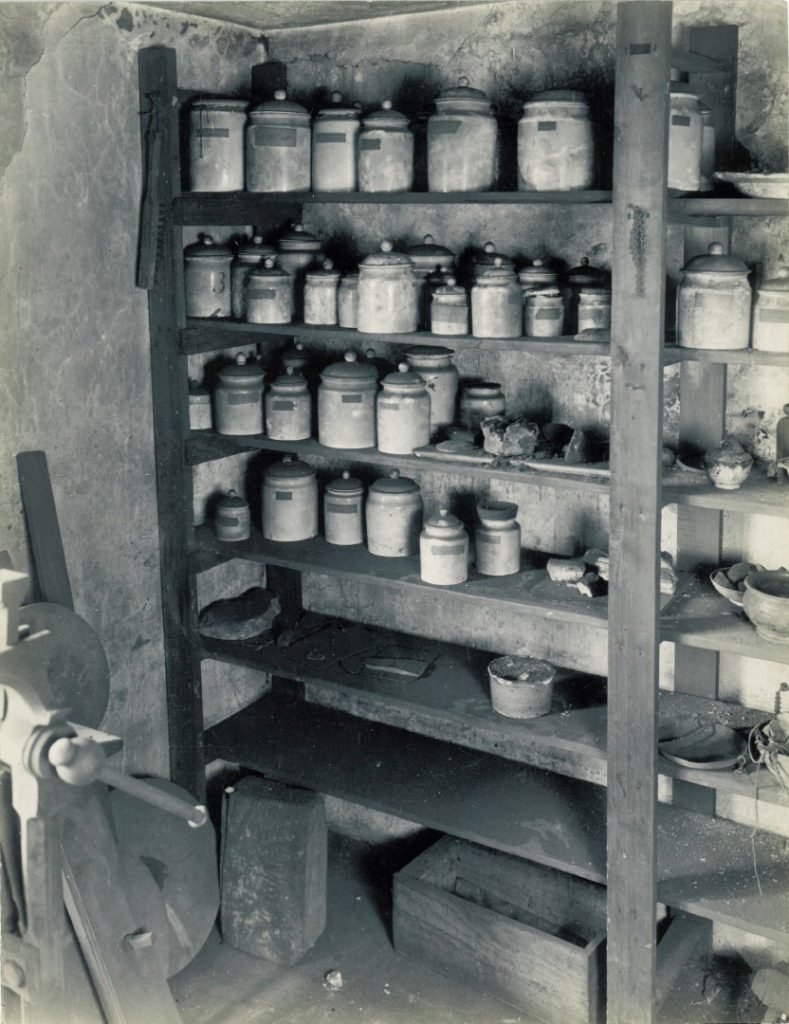
It is difficult to differentiate in the workshop between philosophy and craft. As Watt struggled to establish the nature of heat, and worked on aspects of chemistry, so here we have furnace crucibles with their last contents solidified inside them, chemical glasswares, protective aprons and eye-glasses, experimental tinplate vessels, and a stove which, as well as containing the fire for those experiments, has a Dutch stove on top for cooking food.
In the workshop, then, reality is somewhat at odds with representation. Rather than just Watt of the steam engine, we have Watt the chemist, scientific and musical instrument-maker, even art technician, too. Mechanism and chemistry, philosophy and craft, are closely intermingled. As David Miller has written, ‘ the theoretical Watt and the “cookbook chemist” Watt…were the same person’ (Miller, 2009). Historians have tended to cut what we will call the Watt ‘cake’ vertically, to claim him as a craftsman or a philosopher, but the two are not mutually exclusive. The value of the workshop is in presenting a broad horizontal slice of Watt, emphasizing how whatever project he worked on was underpinned by tangible, craft-based work. The difference here, compared to how craft might have been defined by H W Dickinson, for instance, is that rather than being in large part mechanical and steam-based, Watt’s craft was liminal, stretching across different areas of endeavour without ever quite being describable as any one of them in isolation, and being philosophical, chemical, and artistic too (Dickinson, 1935).
Exploring the liminal nature of Watt and his workshop goes to the heart of why Britain was the first nation to industrialise in the 18th century. Much of the recent appraisal of Watt concerns his status as a philosopher and man of science; recent historiography of the industrial revolution has predominantly focused on the creation of a successful knowledge economy, where ‘useful knowledge’ could be efficiently generated and disseminated to people who could exploit it commercially. The processes by which this could happen have been described by historian Joel Mokyr as the central mechanism of an ‘Industrial Enlightenment’ (Mokyr, 2009). Out of all the European nations, this useful knowledge was most widely diffused in Britain because it had the greatest numbers, both of places where it could be shared (coffee shops or provincial scientific societies, for example) and of people, described by Peter Jones as ‘savant-fabricants’, who combined both scientific ‘why’ with practical ‘how’ knowledge to put it to industrial and commercial use (Jones, 2008).
Watt’s workshop is very much the workplace of a savant-fabricant: alongside his philosophical experiments on the nature of heat and chemistry, we find test-firings of creamware ceramics and ingredients for pottery glazes from Watt’s involvement with the Delftfield Pottery in Glasgow, substances including turmeric, gamboge and cochenilla used in dyestuffs, as well as the chemicals needed to make Watt’s letter-copying press the first successful office machine[13]. A copy made by Watt, and preserved in a drawer, records that ‘Time, labour & money are saved, dispatch & accuracy are attained, and secrecy is preserved by this newly-invented art of copying letters and other writings’[14]. This was only made possible thanks to one of the other items in the workshop, a bundle of hundreds of tiny slips of paper, each recording Watt’s minute variations to the ink recipe used by the copying machine as he refined it. Here are two examples of philosophical experiments turned into viable commercial projects: Delftfield was Scotland’s first successful industrial pottery; and 630 of the copying presses were sold by Watt and his business partner Matthew Boulton in its first year (Kinghorn, 1986) (see Figure 5).
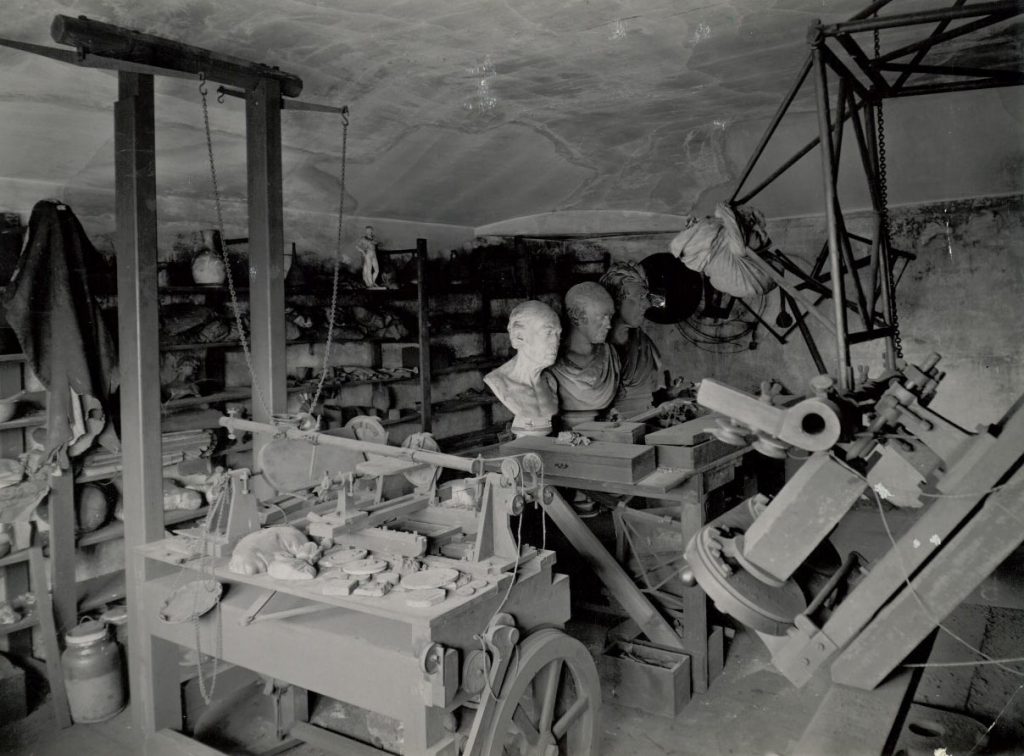
Britain’s successful transition into an industrial economy depended not just on having an idea, then, but on turning an ephemeral concept into a tangible product. These products – engines, lathes, hand-tools, furnaces, chemical apparatus, things for measuring and quantifying – were not just associated directly with science and technology, but were aimed at consumers, too: timepieces, Wedgwood vases, sculpture, cotton cloth and clothing, Boulton silverware and toys, buttons, tableware and a whole panoply of goods. The speed of change was unprecedented. David Landes has commented how ‘the Englishman of the 1750s was closer in material things to Caesar’s legionnaires than to his own great-grandchildren’ (Landes, 1969). Watt didn’t just exist within a world of purely philosophical ideas, but in an intertwined, very real and physical world filled with a multiplicity of new things.
The diversity of objects in the workshop and, importantly, in the Science Museum’s wider collections, allows us to look over Watt’s shoulder and beyond, to other people who played such an important role in Britain’s industrial economy, and who had just as broad a range of interests. The role of craftsmen and artisans was certainly applauded by contemporaries as central to Britain’s industrial success in the 18th century. During the 1730s, Abbe le Blanc wrote how ‘ The English artisan has the quality, extremely commendable, and peculiar to him which is, never swerve from the degree of perfection in his trade which he is master of’ (Porter, 1982). In 1803, Jean-Baptiste Say wrote that ‘the enormous wealth of Britain is less owing to her own advances in scientific acquirements…as to the wonderful practical skills of her adventurers in the useful application of knowledge and the superiority of her workmen in rapid and masterly execution’ (Say, 1855). Coming up to the present, Celina Fox has recorded that ‘modern historians of science and art’ have under-rated Britain’s artisan classes, ‘ without considering the depth of empirical, practical knowledge they represented’ (Fox, 2009).
What is important to reflect on is that craft knowledge of the type given physical embodiment in Watt’s workshop underpinned all sorts of enterprise, both industrial and philosophical, as well as consumer-oriented and decorative, too. This was a world where people like the 1820s iron-master John Tickle, described by Joshua Field as ‘an extraordinary character – a kind of excentric genious a Chymist & a Poet’, could thrive (Hall, 1925-26). Rather than being primarily technological, their stories are deeply human, reflecting that well into the 19th century much manufacturing was small-scale, un-mechanised, and dependent on skilled labour rather than machines, and encompassed huge creativity, cunning, wheeling and dealing. Exploring this wider world also allows us to step away from what John Griffiths described as ‘Wattolatry’, the worship of Watt (Torrens, 2000).
For the Science Museum, exploring this wider world is made possible by the existence of collections which are uniquely rich, and able to tell stories that are populated with a tremendous wealth of people, places, and things. This mixture does, however, raise questions about how we treat the processes of manufacture, in all their forms, within the museum context.
The Museum tends to refer to them under the formal title of ‘engineering’, and they are primarily looked after by the technology and engineering curatorial team. However, we know from evaluation with our visitors that ‘engineering’ is a word that many people are ambivalent about. A characteristic quote from the 2009 evaluation report commissioned to inform the Museum’s redisplay of Watt’s workshop was: ‘It’s non-inspirational until you’re told the details and then it’s really interesting’ (Fisher, Monti, 2009). This reflects the findings of a larger study into modern perceptions of engineering carried out by The Royal Academy of Engineering (The Royal Academy of Engineering, 2007). The word ’engineering’ comes with a lot of baggage attached. For this reason, interpreting Watt just as the engineer that he became during his working life (and it must be emphasised that he did not start out as an engineer, but became one by building on his wide experiences in instrument-making, pottery and very much else) is rather problematic in the museum context.
The solution adopted for Watt’s workshop was to unpick Watt’s approach to making things. Accompanying display cases show items picked from the workshop which would otherwise remain hidden in drawers and boxes. These represent Watt the philosophical entrepreneur, with feet planted firmly in the worlds of experiment and application (or as it was expressed in the exhibition, perhaps a little baldly, ‘turning science into money’). The connections between consumption and making-machines are represented by placing cut-steel buttons alongside engine models, referencing Matthew Boulton’s claim of ‘systematising’ the steam engine business ‘as we have done before in the button manufactory’ (Muirhead, 1858).
Elsewhere in the exhibition are displayed some of Watt’s sculpture collection, including cameos of friends and associates, figures after the Antique, plaster casts of hands, vases and busts, to complement the sculpture-copying machines in the workshop, and present a view of Watt the artist[15]. Pursuing this approach was a conscious strategy to give visitors multiple (perhaps unexpected) handles with which to grasp the central subject of making things, while also conveying the richness of Watt’s multi-faceted world and his status as a savant-fabricant. For the interpretation of Watt and the early industrial revolution, this suggests a need to re-balance away from a deterministic approach where engineers create machines which ‘have an impact’ on society, towards an approach which is much more contingent, and features a subtle interplay between consumption, aesthetics, entrepreneurship and technology.
The question of how to interpret engineering for a museum audience may be one of semantics – engineering as formally defined is just one aspect of a range of activities that apply tremendous creativity to the design and manufacture of three-dimensional artefacts. The need for formal ‘engineering’ galleries and other museum outputs remains, as a strategic imperative for the Science Museum Group, and for the UK as a whole. But, by placing them within the context of other approaches to what we can broadly term ‘making’, the museum can build public interest in this most creative of human activities at many different levels (see Figure 6).
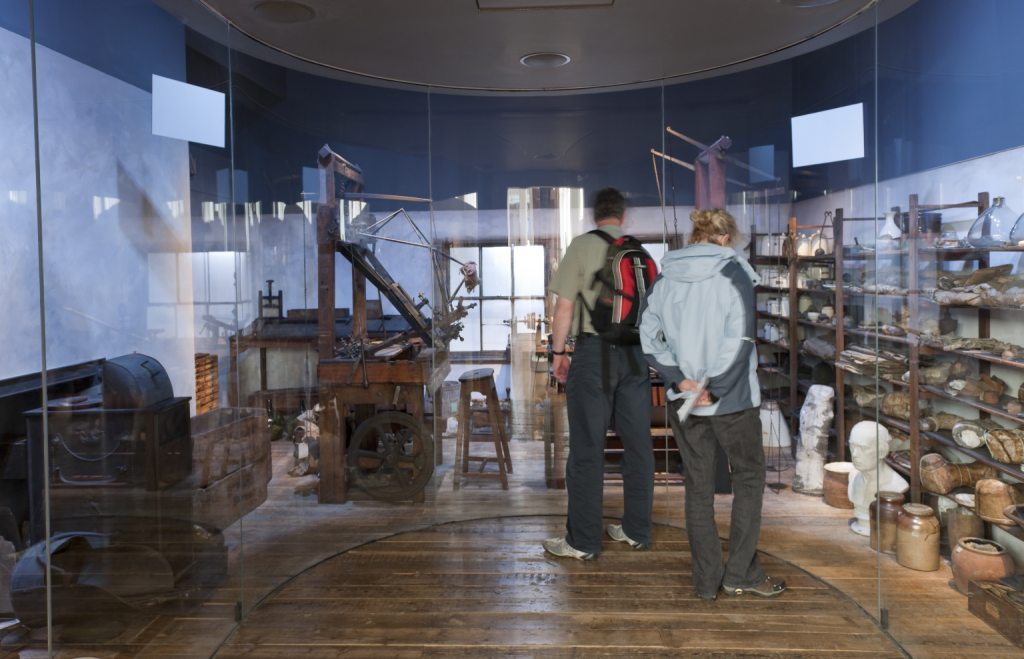
This approach has been successful elsewhere. The V&A organised The Power of Making in 2011 (V&A: The power of making [online]). The Design Museum has produced The Future is Here: A New Industrial Revolution (Design Museum: The future is here [online]). The Science Museum has opened 3D: Printing the Future (The Science Museum: 3D printing the future [online]). Let’s not quibble over whether we call it engineering or not, whether it is a process undertaken by chartered engineers or by craftspeople, or that the industry it happens in isn’t necessarily ‘engineering’. The lesson of Watt’s workshop is that boundaries are there to be crossed; philosophy, sculpture, chemistry and machine-making can happily co-exist in one space. In the 18th century the results were, arguably, the greatest period of economic transformation that Britain has ever seen. The most important thing for the UK now is to get people out there, thinking, designing, making and selling tangible things.

